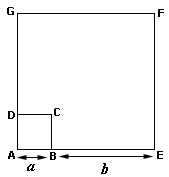Solved Examples and Worksheet for Centre and Scale Factor in Dilation
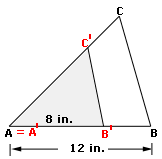
A.
B.
C.
D.
Step: 1
Scale factor = A'B' AB
= 8 12 2 3
[Substitute the values and simplify.]
Step: 2
The scale factor is 2 3
Correct Answer is : 2 3
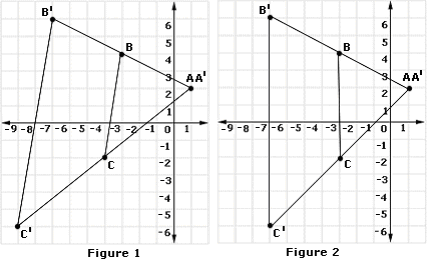
A. Figure 1
B. Figure 2
Step: 1
Since the center of dilation is A, the image of A will be A itself. i.e., A and A′ coincides.
Step: 2
When B is dilated by scale factor of 2 with A as center, B will be the midpoint between A′ and B′.
Step: 3
Coordinates of B′ are (- 7, 6)
[Apply midpoint formula.]
Step: 4
When C is dilated by scale factor of 2 with A as center, C will be the midpoint between A′ and C′.
Step: 5
Coordinates of C′ are (- 9, - 6)
[Apply midpoint formula.]
Step: 6
A′B′C′ is plotted as shown in Figure 1.
Correct Answer is : Figure 1
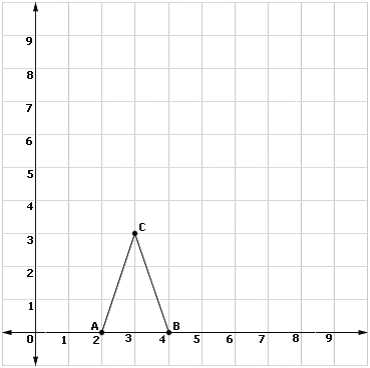
A. A′(6, 0), B′(8, 0) and C′(5, 9)
B. A′(6, 0), B′(12, 0) and C′(9, 9)
C. A′(2, 0), B′(12, 0) and C′(9, 9)
D. A′(2, 0), B′(8, 0) and C′(5, 9)
Step: 1
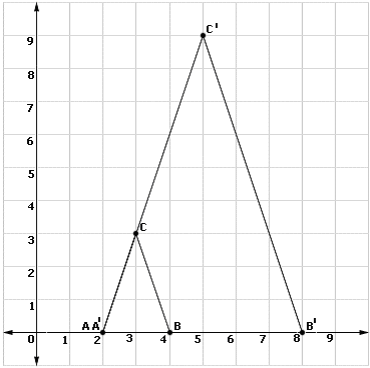
Step: 2
Image of A is A itself. A and A′ coincides.
Step: 3
Image of B is B′. A B ′ A B
Step: 4
B divides AB′ in the ratio 1: 2
Step: 5
Coordinates of B′ are (8, 0).
Step: 6
Image of C is C′. A C ′ A C
Step: 7
Coordinates of C′ are (5, 9).
[Line segment formula.]
Correct Answer is : A′(2, 0), B′(8, 0) and C′(5, 9)
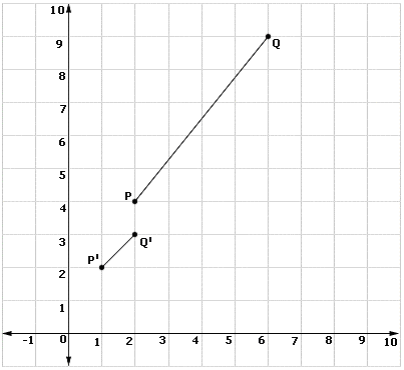
A.
B.
C.
D.
Step: 1
P and Q are (2, 4) and (6, 9)
[Given.]
Step: 2
P′ = (1, 2)
[Multiply the coordinates by the scale factor.]
Step: 3
Q′ = (2, 3)
[Multiply the coordinates by the scale factor.]
Step: 4
PQ = [( 6 - 2 ) ² + ( 9 - 4 ) ²
[Distance formula.]
Step: 5
= 4 1
[Simplify.]
Step: 6
P′Q′ = [( 2 - 1 ) ² + ( 3 - 2 ) ²
[Distance formula.]
Step: 7
P′Q′ = 2
[Simplify.]
Step: 8
PQ - P′Q′ = 4 1 - 2
[Steps 5 and 7.]
Correct Answer is : 4 1 - 2
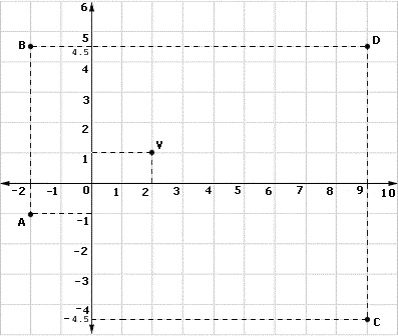
A. B
B. A
C. C
D. D
Step: 1
Point V is (2, 1)
Step: 2
When it is under dilation with a scale factor of 4.5, the image will be (2 × 4.5, 1 × 4.5) = (9, 4.5)
Step: 3
This point is shown as D in the picture.
Correct Answer is : D
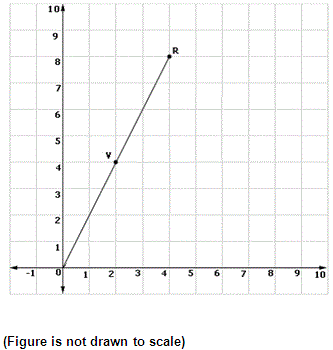
A. (3, 6)
B. (4, 8)
C. (2, 4)
D. (0, 0)
Step: 1
Line segment O-V-R is dilated under a scale factor of 1.5 with origin as the center.
[Given]
Step: 2
Co-ordinates of points O, V and R are (0, 0), (2, 4) and (4, 8) respectively.
Step: 3
To find the image of a point on the coordinate plane under a dilation with center as origin, multiply the co-ordinates with the scale factor.
Step: 4
Image of V (2, 4) = (2 × 1.5, 4 × 1.5)
Step: 5
= (3, 6)
[Simplify]
Step: 6
Therefore, co-ordinates of the point V after dilation is (3,6).
Correct Answer is : (3, 6)

A. SR
B. PQ
C. PS
D. QR
Step: 1
Quadrilateral ABCD is the dilation of quadrilateral PQRS under a scale factor of 1 2
[Given.]
Step: 2
AB | | PQ
[Given.]
Step: 3
Images of vertices P, Q, R and S after dilation are A, B, C and D respectively.
Step: 4
So, AD || PS
[Parallelism of lines of a figure does not change under dilation.]
Correct Answer is : PS
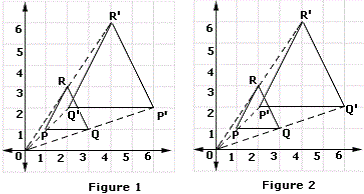
A. Figure 1
B. Figure 2
Step: 1
Triangle PQR is dilated under a scale factor of 2 with origin as the center of dilation.
[Given.]
Step: 2
Images of vertices P, Q and R after dilation are P′, Q′, and R′ respectively.
[Orientation, i.e. the lettering order of a figure does not change under dilation.]
Step: 3
The triangle P′Q′R′ is the dilation of the triangle PQR with respect to the origin.
Step: 4
Therefore, figure 2 represents the dilation of the triangle PQR.
Correct Answer is : Figure 2
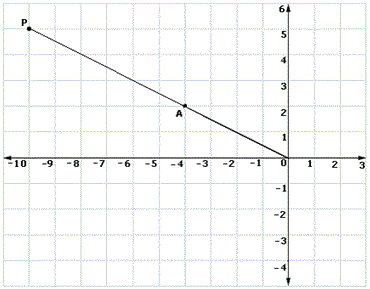
A. Non-collinear
B. Collinear
Step: 1
Line segment O-A-P is dilated under a scale factor of 0.5 with origin as the center.
[Given.]
Step: 2
Co-ordinates of points O, A and P are (0, 0), (-4, 2) and ( - 10, 5) respectively.
Step: 3
To find the image of a point on the coordinate plane under a dilation with center as origin, multiply the co-ordinates with the scale factor.
Step: 4
Image of A (- 4, 2) = (- 4 × 0.5, 2 × 0.5)
Step: 5
(-2, 1)
Step: 6
Image of P ( - 10, 5) = (- 10 × 0.5, 5 × 0.5)
Step: 7
( - 5, 2.5)
Step: 8
We notice that the points O, A′ and P′ are collinear
Step: 9
Therefore, the points O, A′ and P′ are collinear
Correct Answer is : Collinear
- Congruent Triangles-Geometry-Solved Examples
- Similar Figures-Geometry-Solved Examples
- Application of the Pythagorean Theorem-Geometry-Solved Examples
- Special Right Triangles-Geometry-Solved Examples
- Trigonometric Ratios-Geometry-Solved Examples
- Application Problems involving Trigonometric Functions-Geometry-Solved Examples
- Law of Sines and Cosines to Solve Triangles-Geometry-Solved Examples
- Areas of Triangles using Trigonometry-Geometry-Solved Examples
Related Worksheet
- Dilation
